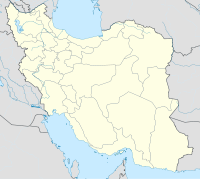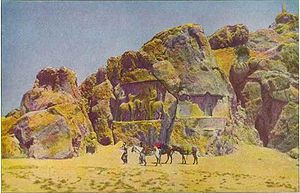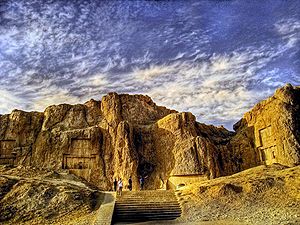- Naqsh-e Rustam
-
Coordinates: 29°59′20″N 52°52′29″E / 29.98889°N 52.87472°E
Further information: Achaemenid architectureNaqsh-e Rustam (Persian: نقش رستم Naqš-e Rostam) also referred to as Necropolis is an archaeological site located about 12 km northwest of Persepolis, in Fars province, Iran. Naqsh-e Rustam lies a few hundred meters from Naqsh-e Rajab.
The oldest relief at Naqsh-i Rustam is severely damaged and dates to c. 1000 BC. It depicts a faint image of a man with unusual head-gear and is thought to be Elamite in origin. The depiction is part of a larger mural, most of which was removed at the command of Bahram II. The man with the unusual cap gives the site its name, Naqsh-e Rostam, "Picture of Rostam", because the relief was locally believed to be a depiction of the mythical hero Rostam.
Naqsh-e Rustam Location in Iran Coordinates: 29°59′20″N 52°52′29″E / 29.98889°N 52.87472°E Contents
Achaemenid tombs
Four tombs belonging to Achaemenid kings are carved out of the rock face. They are all at a considerable height above the ground.
The tombs are known locally as the 'Persian crosses', after the shape of the facades of the tombs. The entrance to each tomb is at the center of each cross, which opens onto to a small chamber, where the king lay in a sarcophagus. The horizontal beam of each of the tomb's facades is believed to be a replica of the entrance of the palace at Persepolis.
One of the tombs is explicitly identified by an accompanying inscription to be the tomb of Darius I the Great (c. 522-486 BC). The other three tombs are believed to be those of Xerxes I (c. 486-465 BC), Artaxerxes I (c. 465-424 BC), and Darius II (c. 423-404 BC) respectively. A fifth unfinished one might be that of Artaxerxes III, who reigned at the longest two years, but is more likely that of Darius III (c. 336-330 BC), last of the Achaemenid dynasts.
The tombs were looted following the conquest of the Achaemenid empire by Alexander the Great.
Sassanid reliefs
Ka'ba-ye Zartosht (cube shaped construction in the foreground) against the backdrop of Naqsh-e Rustam.
 The investiture of Ardashir I.
The investiture of Ardashir I.
Seven oversized rock reliefs at Naqsh-e Rustam depict monarchs of the Sassanid period.
- The investiture relief of Ardashir I (c. 226-242):
- The founder of the Sassanid Empire is seen being handed the ring of kingship by Ahura Mazda. In the inscription, which also bears the oldest attested use of the term 'Iran' (see "etymology of 'Iran'" for details), Ardashir admits to betraying his pledge to Artabanus IV (the Persians having been a vassal state of the Arsacid Parthians), but legitimizes his action on the grounds that Ahura Mazda had wanted him to do so.
- The triumph of Shapur I (c. 241-272):
- This is the most famous of the Sassanid rock reliefs, and depicts Shapur's victory over two Roman emperors, Valerian and Philip the Arab. A more elaborate version of this rock relief is at Bishapur.
- The "grandee" relief of Bahram II (c. 276-293):
- On each side of the king, who is depicted with an oversized sword, figures face the king. On the left stand five figures, perhaps members of the king's family (three having diadems, suggesting they were royalty). On the right stand three courtiers, one of which may be Kartir. This relief is to the immediate right of the investiture inscription of Ardashir (see above), and partially replaces the much older relief that gives Naqsh-e Rustam its name.
- The two equestrian reliefs of Bahram II (c. 276-293):
- The first equestrian relief, located immediately below the fourth tomb (perhaps that of Darius II), depicts the king battling a mounted Roman soldier.
- The second equestrian relief, located immediately below the tomb of Darius I, is divided into two registers, an upper and a lower one. In the upper register, the king appears to be forcing a Roman enemy from his horse. In the lower register, the king is again battling a mounted Roman soldier.
- Both reliefs depict a dead enemy under the hooves of the king's horse.
- The investiture of Narseh (c. 293-303):
- In this relief, the king is depicted as receiving the ring of kingship from a female figure that is frequently assumed to be the divinity Aredvi Sura Anahita. However, the king is not depicted in a pose that would be expected in the presence of a divinity, and it hence likely that the woman is a relative, perhaps Queen Shapurdokhtak.
- The equestrian relief of Hormizd II (c. 303-309):
- This relief is below tomb 3 (perhaps that of Artaxerxes I) and depicts Hormizd forcing an enemy (perhaps Papak of Armenia) from his horse. Immediately above the relief and below the tomb is a badly damaged relief of what appears to be Shapur II (c. 309-379) accompanied by courtiers.
Archaeology
In 1923, the German archaeologist Ernst Herzfeld made casts of the inscriptions on the tomb of Darius I. Since 1946, these casts are held in the archives of the Freer Gallery of Art and the Arthur M. Sackler Gallery, Smithsonian Institution, in Washington, DC.
Naqsh-e Rustam was excavated for several seasons between 1936 and 1939 by a team from the Oriental Institute of the University of Chicago, led by Erich Schmidt.[1]
See also
- Persepolis
- Behistun Inscription
- Cities of the Ancient Near East
- Ka'ba-i Zartosht (The "Cube of Zoroaster", a monument at Naqsh-e Rustam)
- List Of Colossal Sculpture In Situ
- Naqsh-e Rajab
- Pasargadae (Tomb of Pasargadae Cyrus the Great)
- Taq-e Bostan (Rock reliefs of various Sassanid kings)
- Valley of the Kings
- Ming and Qing Imperial Tombs
Notes
- ^ [1] E. F. Schmidt, Persepolis III: The Royal Tombs and Other Monuments, Oriental Institute Publications 70, University of Chicago Press, 1970, ISBN 0-226-62170-7
Bibliography
- Herrmann, G. & Curtis, V. S. (2003). "Sasanian Rock Reliefs". Encyclopedia Iranica. Costa Mesa: Mazda. http://www.iranica.com/newsite/articles/sup/SasanianReliefs.html.
- Hubertus von Gall "NAQŠ-E ROSTAM" in Encyclopaedia Iranica [2]
- Lendering, Jona (2009). "Naqsh-i Rustam". Amsterdam: Livius. http://www.livius.org/na-nd/naqsh-i-rustam/naqsh-i-rustam.html.
- Unknown (2005). "Naghsh-e-Rostam". http://landofaryan.atspace.com/rostam.htm.
External links
 Media related to Naqsh-e Rustam at Wikimedia Commons
Media related to Naqsh-e Rustam at Wikimedia Commons- Ernst Herzfeld Papers, Series 5: Drawings and Maps, Records of Naqsh-i Rustam Collections Search Center, S.I.R.I.S., Smithsonian Institution, Washington, D.C.
 Fars Province, Iran
Fars Province, IranCapital 
Counties (A-K)
and CitiesAbadeh • Bahman • Izadkhvast • Soghad • SurmaqArsanjanSurian • KorehiDarab • Jannat ShahrEqlid • SedehEstahban • Ij • RonizFasa • Now Bandegan • Sheshdeh • ZahedshahrFiruzabad • MeymandGerash CountyKavar CountyKharameh CountyKharamehKhonj CountySafashahr • QaderabadCounties (L-Z)
and CitiesLamerd • Ahel • Ala-e Marvdasht • EshkananNurabad • Khumeh ZarMarvdasht • Kamfiruz • Ramjerd • SeyyedanMohr • Asir • Galleh Dar • VaraviPasargad CountySaadat ShahrQir and Karzin CountyQir • Efzar • KarzinRostam CountySarvestan CountySarvestanArdakan • Beyza • HamashahrZarrin Dasht CountyHajjiabad • Dowbaran • Shahr-e PirLandmarks Afif-Abad Garden · Amir's dam · Arg of Karim Khan · Barmdelak lagoon · Bishapur · Delgosha Garden · Eram Garden · Estakhr · Ghal'eh Dokhtar · Ka'ba-ye Zartosht · Kazerun fire temple · Lake Parishan · Naqsh-e Rajab · Naqsh-e Rustam · Palace of Ardashir · Pars museum · Pasargadae · Persepolis · Qavam House · Qur'an Gate · Saadi's mausoleum · Sarvestan Sassanian palace · Shah Cheragh · Colossal Statue of Shapur I in Shapur cave · Tangeh Bolaghi · Hāfezieh · Tounbbot · Vakil Bath · Vakil Bazaar · Vakil Mosque
Categories:- 3rd-century architecture
- 5th-century BC architecture
- Marvdasht complex
- Sassanid architecture
- Archaeological sites in Iran
Wikimedia Foundation. 2010.






